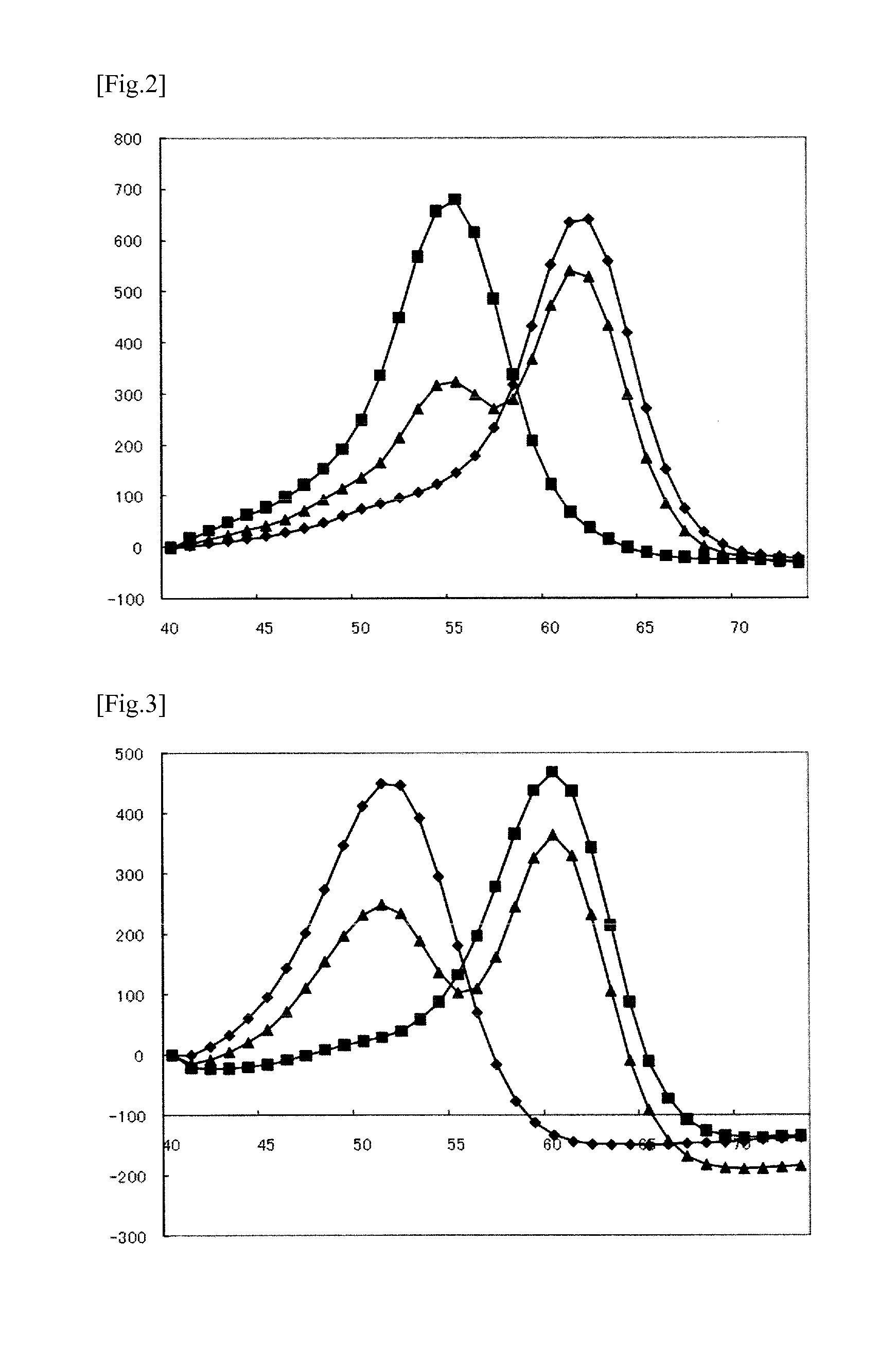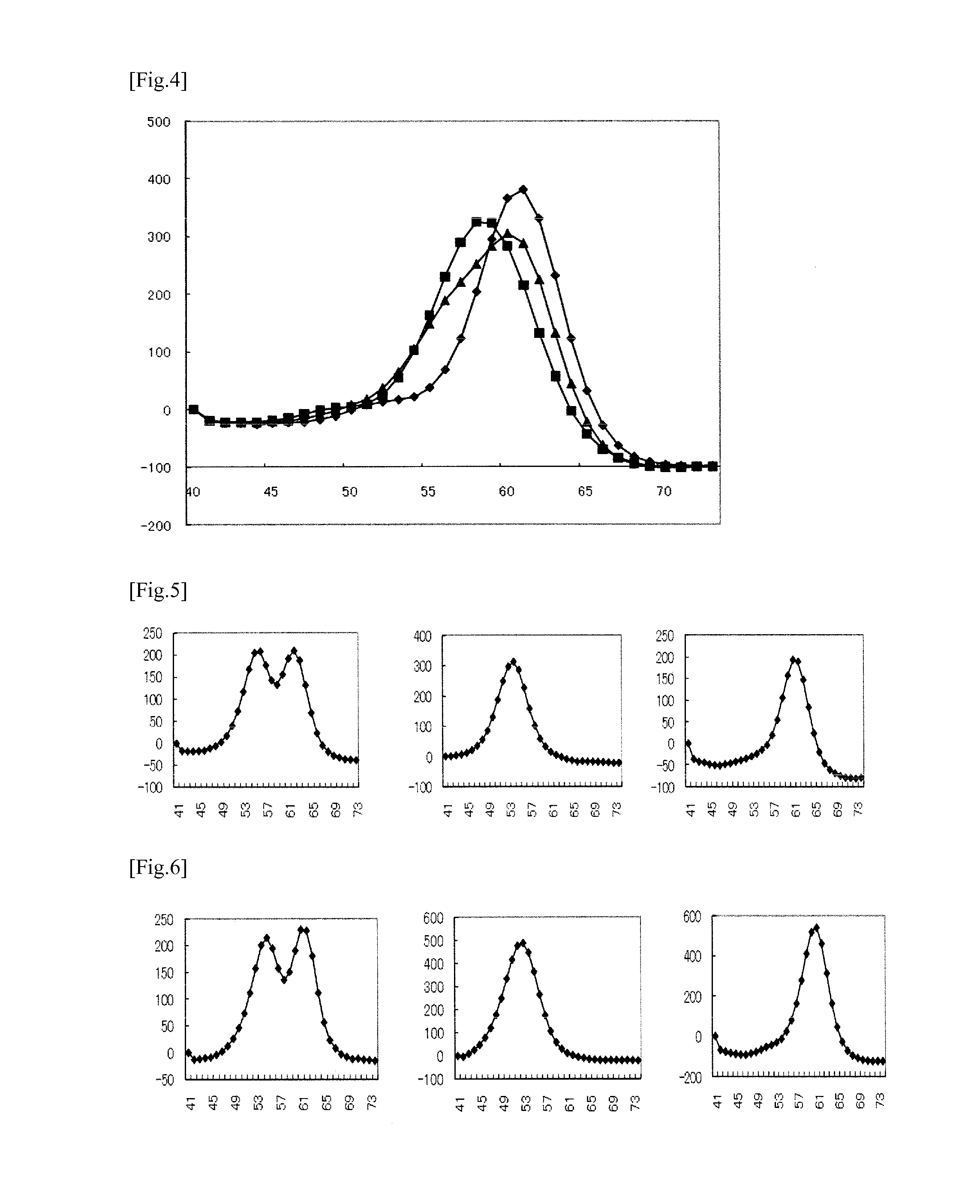Probes for Detecting Paraoxonase 1 Gene Polymorphism (Q192R) and Methods of Use Thereof
a technology of paraoxonase 1 and probes, which is applied in the field of nucleic acid probes and kits for detecting paraoxonase 1 (pon1) gene polymorphisms, can solve the problems of insufficient elucidation of the physiological function of pon3, inability to detect the pharmacological effect of clopidogrel, and high cost of extraction of genomic dna from whole blood for investigation of the effect of clopid
- Summary
- Abstract
- Description
- Claims
- Application Information
AI Technical Summary
Benefits of technology
Problems solved by technology
Method used
Image
Examples
example 1
Use of a Single Probe for Detection of Template Oligonucleotide for PON1
[0109]Based on the nucleotide sequence comprising the site of the PON1 gene polymorphism (Q192R) rs662 (SEQ ID NO:1), the probe shown in Table 4 having C at its 3′-end was designed. In Table 4, the position of the probe is represented by nucleotide positions in the nucleotide sequence shown in SEQ ID NO:1. Labeling with Pacific Blue was carried out according to a conventional method.
[0110]The sequences of the template oligonucleotides (wild-type (SEQ ID NO:18) and mutant type (SEQ ID NO:19)) used as the subject sequences to be detected are shown in Table 4. In Table 4, the positions of the oligonucleotides are represented by nucleotide positions in the nucleotide sequence shown in SEQ ID NO:1. In case of heterozygous type, the template oligonucleotides of SEQ ID NOs:18 and 19 were mixed at a ratio of 1:1 to provide the sample.
TABLE 4SEQ IDGC contentTmNameSequence (5′→3′)PositionNO:mer(%)Tm (mt)(WT)ΔTmPON1 (Q192R...
example 2
Use of a Single Probe for Detection of Template Oligonucleotide for PON1
[0115]Based on the nucleotide sequence comprising the site of the PON1 gene polymorphism (Q192R) rs662 (SEQ ID NO:1), the probe shown in Table 6 having C at its 5′-end was designed. In Table 6, the position of the probe is represented by nucleotide positions in the nucleotide sequence shown in SEQ ID NO:1. Labeling with TAMRA was carried out according to a conventional method.
[0116]The sequences of the template oligonucleotides (wild-type (SEQ ID NO:18) and mutant type (SEQ ID NO:19)) in Table 4 were used as the subject sequences to be detected. In case of heterozygous type, the template oligonucleotides of SEQ ID NOs:18 and 19 were mixed at a ratio of 1:1 to provide the sample.
TABLE 6SEQ IDGC contentTmNameSequence (5′→3′)PositionNO:mer(%)Tm (mt)(WT)ΔTmPON1 (Q192R) probe2(TAMRA)-cccctacttacAatcctg-P290-30710185036.247.211*The nucleotide denoted by the upper case letter indicates the position of the mutation. P a...
example 3
Use of a Plurality of Probes for Detection from Purified Human Genomic DNA or Whole Blood
[0128]Polymorphic regions were amplified as described below from purified human genomic DNA or whole blood by PCR using the primers described below, and Tm analysis was carried out using the probes shown in SEQ ID NOs:2, 24 and 28.
[0129]First, based on the nucleotide sequence comprising the site of the PON1 gene polymorphism (Q192R) rs662 (SEQ ID NO:1), the primers shown in Table 10 were designed such that the polymorphic site may be amplified. In Table 10, the positions of the primers are represented by nucleotide positions in the nucleotide sequence shown in SEQ ID NO:1.
[0130]Subsequently, based on the nucleotide sequence comprising the site of the CYP2C19*2 gene polymorphism (G681A) (SEQ ID NO:21), primers shown in Table 11 were designed such that the polymorphic site may be amplified. In Table 11, the positions of the primers are represented by nucleotide positions in the nucleotide sequence...
PUM
| Property | Measurement | Unit |
|---|---|---|
| detection wavelength | aaaaa | aaaaa |
| detection wavelength | aaaaa | aaaaa |
| detection wavelength | aaaaa | aaaaa |
Abstract
Description
Claims
Application Information
 Login to View More
Login to View More - R&D
- Intellectual Property
- Life Sciences
- Materials
- Tech Scout
- Unparalleled Data Quality
- Higher Quality Content
- 60% Fewer Hallucinations
Browse by: Latest US Patents, China's latest patents, Technical Efficacy Thesaurus, Application Domain, Technology Topic, Popular Technical Reports.
© 2025 PatSnap. All rights reserved.Legal|Privacy policy|Modern Slavery Act Transparency Statement|Sitemap|About US| Contact US: help@patsnap.com



